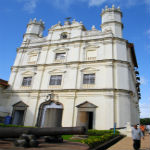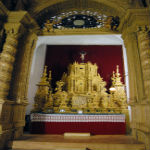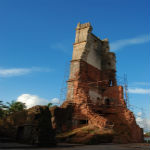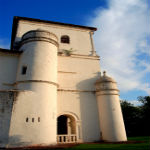GOA
CHURCHES IN GOA
In the Northern Goa district lies the historical city of Vedha Goa or
Old Goa (vedha in Portuguese means "old"). Panjim, the capital city of
Goa, is about ten kilometers west of Old Goa. The city of Old Goa was
constructed in the 15th century by the Bijapur Sultanate.
From 16th century till its abandonment due to plague in the 18th
century, it was the capital of Portuguese India. The city still holds
the churches and covenants of those times, which reflect the Portuguese
culture clearly. The architectural styles of these monuments of
historical significance depict a combination of Renaissance and Baroque
styles and the main materials used to construct these churches are
laterite and plaster. Labeled as "Rome of the East" and "Golden Goa",
this city has been marked by UNESCO as a World Heritage Site.
The churches and covenants of Old Goa are remnants of the existence of
Portuguese rule in the area. The 16th and 17th centuries saw the
construction of several cathedrals and churches, including Basilica of
Bom Jesus , Se Cathedral, Church of Lady of Rosary, Church of St.
Francis of Assisi and Church of St. Augustine. These churches are
affiliated to different congregations. The churches are aesthetically
designed and consist of paintings done on wooden borders that were fixed
between beautifully designed floral panels. These institutions and
magnificent buildings are legacies of the Portuguese culture and social
life, and are still maintained by the Christians of this area. In Goa
educational contribution of the churches is immense. All of these are
now a part of Archdiocese of Goa, most of which are declared as
protected sites.
The monuments are open on all the days, including public, state and national holidays, from sunrise to sunset.
Some of the most famous Churches in Goa are listed below:
The monuments are open on all the days, including public, state and national holidays, from sunrise to sunset.
Some of the most famous Churches in Goa are listed below:
Church of St. Francis Of Assisi, Old Goa: The Portuguese
built the Church of St. Francis of Assisi in 1661. This church lies on
the western side of Se Cathedral, with the Palace of the Archbishop
in-between. Laterite blocks were used in its construction that is
lime-plastered. The convent, which is an annexure of the church, houses
an archaeological museum. The statue of St. Francis of Assisi, made of
wood, embellishes the pedestal that bears the emblem of Franciscans. A
statue of Our Lady of Miracles, brought from Jaffna, Sri Lanka, adorns
the facade. The statues of St. Peter, St. Michael and St. Paul are also
seen here. Painted panels portraying the life of St. Francis of Assisi
are retained on the adjoining walls.
- Basilica of Bom Jesus, Old Goa: Goa's most famous Jesuit
church, the Basilica of Bom Jesus, situated in Old Goa, is the first
minor basilica in India. The church is dedicated to Bom Jesus, meaning
infant or good Jesus. This model of elegance and simplicity, now in
ruins, is the most revered church in the Christian community worldwide.
Jesuit architecture is quite apparent from its design and structure. The
consecration of the church was done by the then Archbishop of Goa, Fr.
Alexia de Menezes upon its completion on 15 May 1605. The facade of the
church has the letters 'HIS' inscribed on it, that are the first three
letters of Lord Jesus Christ in Greek. The figure of infant Jesus is
placed on the main altar that is richly glided. A large statue of St.
Ignatius Loyola, founder of the Jesuits, is above the altar. The chapel
of the Blessed Sacrament is placed in the transept that is on the
northern side. The mortal remains of St. Francis Xavier are kept intact
in a decorated casket in the basilica.
- Sunday: 10:30 a.m. to 6:30 p.m.
- Weekdays: 9:00 a.m. to 6:30 p.m.
- Sunday mass: 8 a.m. and 9:15 a.m.
- Weekdays mass: 7 a.m. and 8 a.m.
- Ruins of Church of St. Augustine: Half a kilometer away from the Se Cathedral lies the beautiful St. Cajetan Church. Modeled as the Basilica of St. Peter of Rome, this church reflects Corinthian architecture. The richly carved glided altars are made following the Baroque style. The church is dedicated to Our Lady of Divine Providence and is named after St. Cajetan, the founder of order of Theatine, who was a contemporary of St. Francis Xavier. The church was built by Italian friars in 1661. The altars of the church are decorated with Italian-school paintings, some of which depicts the life of St Cajetan.
- Ruins of Church of St. Augustine: Half a kilometer away from the Se Cathedral lies the beautiful St. Cajetan Church. Modeled as the Basilica of St. Peter of Rome, this church reflects Corinthian architecture. The richly carved glided altars are made following the Baroque style. The church is dedicated to Our Lady of Divine Providence and is named after St. Cajetan, the founder of order of Theatine, who was a contemporary of St. Francis Xavier. The church was built by Italian friars in 1661. The altars of the church are decorated with Italian-school paintings, some of which depicts the life of St Cajetan.
- St. Cajetan Church, Old Goa: The St Cajetan Church is located in Old Goa. It is famous for the high vault on which are inscribed the words of Christ 'My House Is a House of the Words of Christ". St Cajetan, lies about half a km away to the north east of the Se Cathedral and close to the ruins of the Viceregal Palace.
- Lady Rosary Church: On the western side of the Holy Hill, called Monte Santo, lies the Church of Our Lady of Rosary. The church gives an excellent view of the Mandovi River and Divar Island. History evidences that in 1510, Alfonso de Albuquerque organized his army at this site and eventually became victorious. This church holds a high regard as St. Francis Xavier imparted his teachings here to the locals. The main altar has the image of the Lady of Rosary.





A correction is necessary - "Velha" means old - "Velha" its writen always with LH never DH
ReplyDeleteexample : VELHA CATEDRAL = OLD CATHEDRAL
VELHO CASTELO = old castle. The A or O in the end of the word tell us the gender.In Portuguese language we have words that shows us the gender of the subject but i guess that nobody cares about that - thank you JS